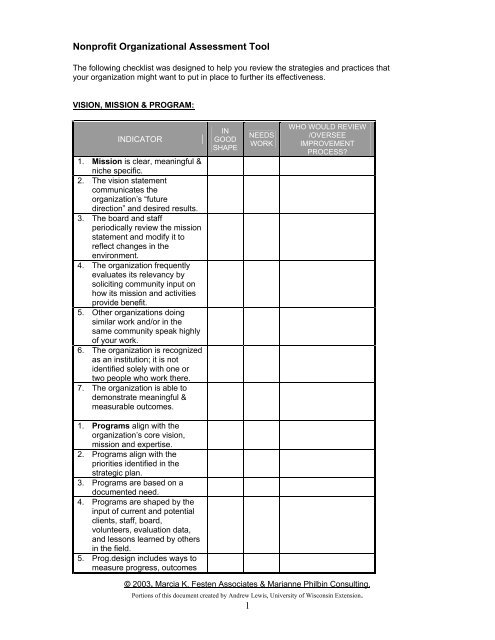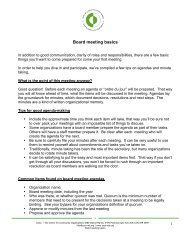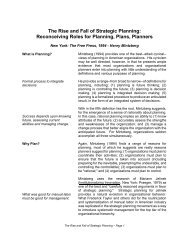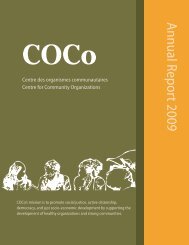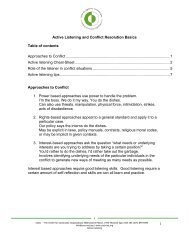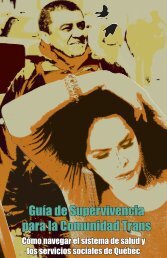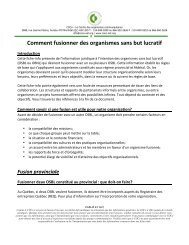Nonprofit Organizational Assessment Tool â PDF - COCo
Nonprofit Organizational Assessment Tool â PDF - COCo
Nonprofit Organizational Assessment Tool â PDF - COCo
Create successful ePaper yourself
Turn your PDF publications into a flip-book with our unique Google optimized e-Paper software.
<strong>Nonprofit</strong> <strong>Organizational</strong> <strong>Assessment</strong> <strong>Tool</strong>The following checklist was designed to help you review the strategies and practices thatyour organization might want to put in place to further its effectiveness.VISION, MISSION & PROGRAM:INDICATOR1. Mission is clear, meaningful &niche specific.2. The vision statementcommunicates theorganization’s “futuredirection” and desired results.3. The board and staffperiodically review the missionstatement and modify it toreflect changes in theenvironment.4. The organization frequentlyevaluates its relevancy bysoliciting community input onhow its mission and activitiesprovide benefit.5. Other organizations doingsimilar work and/or in thesame community speak highlyof your work.6. The organization is recognizedas an institution; it is notidentified solely with one ortwo people who work there.7. The organization is able todemonstrate meaningful &measurable outcomes.INGOODSHAPENEEDSWORKWHO WOULD REVIEW/OVERSEEIMPROVEMENTPROCESS?1. Programs align with theorganization’s core vision,mission and expertise.2. Programs align with thepriorities identified in thestrategic plan.3. Programs are based on adocumented need.4. Programs are shaped by theinput of current and potentialclients, staff, board,volunteers, evaluation data,and lessons learned by othersin the field.5. Prog.design includes ways tomeasure progress, outcomes© 2003, Marcia K. Festen Associates & Marianne Philbin Consulting.Portions of this document created by Andrew Lewis, University of Wisconsin Extension.1
FINANCIAL MANAGEMENT & OPERATIONS:INDICATOR1. Yearly auditsconducted, read andunderstood2. Quarterly financialstatements areprepared, using aconsistent format, andreviewed by the board.3. Senior staff and boardmembers can citesimple budget figures &answer basic financialquestions at amoment’s notice.4. Board members andstaff leaders are trainedon how to read,interpret and use theorganization’s financialstatement.5. Budget process followsan annual calendar;board approves annualbudget & plan6. Written financial controlpolicies exist, includingthe handling of cashand deposits, andapproval over spendingand disbursements.7. There are writtenguidelines on who canauthorize debt.8. The board reviews thatstatus of all debt on anongoing basis.9. The treasurer reportsthe number of days ofcash on hand at theend of each reportingperiod.10. Monthly cash flowstatements areprepared and reviewedby staff/board.11. Space/facilities needsare monitored; afacilities plan is in place12. The budget is used asa management tool.INGOODSHAPENEEDSWORKWHO WOULDREVIEW/OVERSEEIMPROVEMENT PROCESS?© 2003, Marcia K. Festen Associates & Marianne Philbin Consulting.Portions of this document created by Andrew Lewis, University of Wisconsin Extension.4
PLANNINGINDICATOR1. Strategic plan is inplace.2. An evaluation processand performanceindicators measure theorganization’s progresstoward its goals, per thestrategic plan.3. The strategic plan isreviewed annually by staffand board, and adjustedas necessary.4. The organizationnetworks and/orcollaborates with otherorganizations to producethe most comprehensiveand effective servicesand programs.5. Board, staff, volunteers,service recipients, keyconstituents and generalmembers of thecommunity are involvedwith the planningprocess.6. The plan identified thechanging communityneeds, including theagency’s strengths,weaknesses,opportunities, andthreats.7. The plan prioritizes theorganization’s goals andhas timelines for theiraccomplishment8. The plan identifies keyconstituents, their serviceexpectations, and howthe organization willrespond to them.9. The approach or methodfor attaining goals andresolving specific issueshas been developedbased on direct input,research, andunderstanding of “bestpractices.”INGOODSHAPENEEDSWORKWHO WOULDREVIEW/OVERSEEIMPROVEMENT PROCESS?© 2003, Marcia K. Festen Associates & Marianne Philbin Consulting.Portions of this document created by Andrew Lewis, University of Wisconsin Extension.5
RESOURCE DEVELOPMENT:INDICATOR1. Fundraising plan is inplace that includesmultiple strategies forrevenue generation.2. Fundraising is staffed.3. Plans are reviewedannually, strategiesevaluated continually.4. 100% of the board givesto the organization—it’sa written policy!5. Fundraising team worksclosely with programteam on annualplanning, and onreporting to donors.6. Fundraising alsounderstood as publiceducation,communications, way toreinforce program—notjust as means to abudget goal.7. The organization knowsand follows funders’policies relative tounexpended income,restricted income, andreporting requirements.8. The organizationbudgets fundraisingadequately, understandsit must invest infundraising to surviveand grow.9. Fundraising practicesfollow AFP ethicalstandards10. All board participates infundraising efforts.11. The organization hasinvested in technologythat builds capacity forresource development.12. The organization doesappropriate prospectresearch, maintainsrecords of past givingthat will assist withcultivation anddevelopment of donors.INGOODSHAPENEEDSWORKWHO WOULDREVIEW/OVERSEEIMPROVEMENT PROCESS?© 2003, Marcia K. Festen Associates & Marianne Philbin Consulting.Portions of this document created by Andrew Lewis, University of Wisconsin Extension.6
Characteristics and Practices ofLess Effective <strong>Nonprofit</strong> Organizations More Effective <strong>Nonprofit</strong> OrganizationsMission, Vision, ProgramPrompted by individual charitable impulseProgram shaped exclusively by service providersView of work is broad, mission is vagueSome tendency to serve private interestPrograms don’t always tie into missionPrompted by thoughtful, collective decisionsProgram shaped equally by service recipientsMission is clear, view is strategic, niche-specificClearly focused on serving public interestClarity of mission evident in focused programsTeam, Structure, GovernanceBoard and staff roles unclear, meldedBoard micro-manages all functions,even after start-up phase is overVolunteer development haphazardBoard believes policies are “implicit” in workDecision-making dominated by founders or othersmall group of stakeholdersBoard gets involved in hiring all staffProgresses by fits and starts, project to projectBoard nominations are eccentric and random—Members drawn from same well.Board and staff roles clear, defined and separateBoard sees chief duties as policy-setting,overall stewardship and financial healthVolunteers trained, managed, rewardedBoard makes policies “explicit” in writingDecision-making by board as whole, followingestablished channels and protocolsBoard only hires ED; ED hires othersDevelops & regularly consults strategic plan; usesplanning as a tool for direction settingNominations process follows clear procedures –Members diverse and therefore board talent-richResource Development, Financial Management, OperationsBudgeting often begins with what theBudgeting begins with assessment of needs, andorganization thinks it can or should spend with what the org. thinks it can or should raiseOrganization regularly spends outside budget Organization uses budget as management toolFundraising is scattershot, whimsical, anafterthought; often heavy reliance on a few coredonorsOrganization hesitant to invest in fundraisinginfrastructure or communications; fears spendingon anything but programSees fundraising only as means to budget goalExclusive reliance on government and foundationgrantsFew board members make financialcontributions, think volunteering is enoughFrequent crisis cash flow borrowingNo one reads or understands the budget or auditLives within inadequacies of existing space,often tailoring program to the spaceFundraising is staffed, annualized, maintained byclear systems and multiple strategiesOrganization understands it must invest in itselfto survive and grow; to publicize & deliverprograms properly, and to reach out to newconstituentsAlso sees fundraising as public education &communications, a way to reinforce programIndividual contributors also part of the mix, as wellas earned income, corporate support100% board giving, no matter what the levelShort and long-term financial planning andcash management policies in placeLeadership understands what audit conveysDevelops facilities plan so that space canultimately be tailored to program needsPrepared by Marianne Philbin & Marcia Festen, Chicago, IlContact maphi@aol.com or marcia@festen.net ©2003.1


